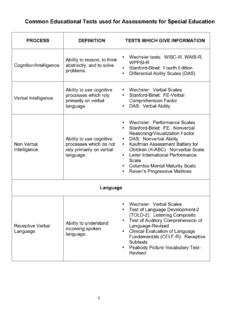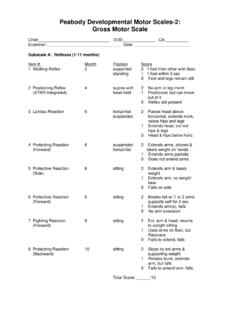Transcription of GOAL ATTAINMENT SCALING
1 Second Edition GOAL ATTAINMENT SCALING : Description, Utility, and Applications in Pediatric Therapy Services Resource Book/. Training Manual Second Edition GOAL ATTAINMENT SCALING : Description, Utility, and Applications in Pediatric Therapy Services Prepared By: Janette McDougall, Research Associate, Thames Valley Children's Centre, London, Ontario Tel: 519-685-8680, ext. 53377. Email: Gillian King, Research Scientist, Child and Parent Resource Institute, London, Ontario Tel: 519-858-2774, ext. 2912. Email: 2007 McDougall & King Preface Goal ATTAINMENT SCALING (GAS) is becoming an increasingly popular technique for evaluating the functional goal ATTAINMENT of children receiving pediatric therapy services.
2 This manual is intended as a resource for clinicians, administrators, and researchers who would like to use GAS to monitor change over time for individual clients and/or to evaluate the effectiveness of programs and services. The authors of this manual have provided training to small and large groups of clinicians seeking to use GAS for clinical purposes. The authors have also conducted program evaluation studies of pediatric therapy services using this individualized measurement approach. We hope that the information provided here will be helpful to you when using GAS. We also invite you to contact us at Thames Valley Children's Centre, tel: 519-685-8680, ext.
3 53377, or by email: if you require further information. Janette McDougall Research Associate Thames Valley Children's Centre TABLE OF CONTENTS. Brief History of Goal ATTAINMENT SCALING (GAS)..1. Use of GAS in Pediatric Therapy Description of GAS ..4. Merits of Potential Limitations of GAS ..6. Guidelines for Using Number of goals to Set .. 7. Determining Who Sets goals .. 7. Minimizing Bias in Goal Setting .. 8. Criteria for Writing goals in GAS Format .. 9. Rating goals After Intervention .. 11. Demonstrating the Reliability of the GAS Rating Procedure .. 12. Using GAS for Program Evaluation ..13. Appendix A - GAS Training Procedures ..14. Appendix B - Common Errors in Writing GAS Scales.
4 15. Appendix C - GAS Appendix D - Examples of GAS Scales in Pediatric Therapy ..19. Goal ATTAINMENT SCALING (GAS). Brief History GAS was first developed by Kiresuk & Sherman (1968) and used to evaluate mental health programs In 1969, the National Institute of Mental Health provided funding to develop, implement, and disseminate GAS. GAS has since been used in evaluating service delivery in many fields ( , rehabilitation, education, medicine, corrections, nursing, and social work). Kiresuk et al. (1994) have written a book which serves as both a user manual and reference work for GAS. Use of GAS in Pediatric Therapy Services GAS has been used in several studies of the effects of pediatric therapy services for children with developmental , physical, and communication needs ( , Brown, Effgen, & Palisano, 1998.)
5 Ekstr m, Johansson, Granat, & Carlberg, 2005; King et al., 1998;. King, McDougall, Tucker et al., 1999; Palisano, Haley, & Brown, 1992; Palisano, 1993; Steenbeek, Meester-Delver, Becher, &. Lankhorst, 2005; Stephens & Haley, 1991). McDougall & King, 2007 1. Brown et al. (1998). Examined the effects of physical therapy intervention on attaining gross motor goals in 24 individuals aged 3 to 30 years with severely limited physical and cognitive abilities GAS was used to measure change in gross motor ability after 18 weeks of twice-weekly therapy intervention 3 goals were set for each participant, with one goal randomly selected as a control goal Participants' improvement on goals was assessed during therapy, recess and at home GAS indicated that participants demonstrated improvement during therapy.
6 Which did not consistently transfer to the recess and home settings Participants showed greater improvement on treatment goals than on control goals during therapy, but there were no differences between treatment and control goals during recess and at home Ekstr m et al. (2005). Evaluated functional training for children with cerebral palsy using GAS. The intervention was carried out in the context of natural settings 14 children aged 6 months to 6 years participated in the 5-month intervention 77% of goals were attained King et al. (1998). One objective of this feasibility study was to examine the utility of GAS for evaluating therapy services provided to children with special needs in the regular school setting 16 children receiving an average of 13 therapy sessions over 4 to 5 months had 1 to 3.
7 Functional goals set in one of 3 target areas: communication, productivity, or mobility Findings showed that all children made improvements on their goals Study concluded GAS was a responsive measure of children's functional change in the 3. target areas and was appropriate for evaluating therapy outcomes in the school setting King, McDougall, Tucker et al. (1999). One objective of this program evaluation study was to use GAS to measure the extent to which children with special needs achieved their individual, functional goals in the school setting 50 children received an average of 17 therapy sessions throughout the school year Each child worked toward 1 to 2 goals set in one of the following target areas: communication, productivity, or mobility Findings showed that 98% of the children made improvement on their functional goals after receiving intervention, and maintained that improvement 5 to 6 months later McDougall & King, 2007 2.
8 Palisano et al. (1992). Tested sensitivity of GAS to measure change and involved 65 infants 3 to 30 months old with motor delays as measured by the peabody developmental motor Scales (PDMS). Therapists set 2 motor goals per infant prior to a 6 month intervention period Findings showed that the infants scored higher than expected at the end of intervention Study results support the validity of GAS as a responsive measure of motor change in infants with motor delays Palisano (1993). Study examined the validity and responsiveness of GAS; GAS was compared to the PDMS. 2 goals were set for 2 consecutive 3 month periods for 21 infants with motor delay Study results support the content validity and the responsiveness of GAS, and provide evidence that GAS and the PDMS measure different aspects of motor development Steenbeek et al.
9 (2005). Evaluated the effect of botulinum toxin type A treatment for children with cerebral palsy using GAS. 11 children participated in the study goals were recorded weekly for 14 weeks 9 of 11 children showed significant improvement on their goals Stephens & Haley (1991). Study investigated the validity and sensitivity to change of the PDMS and GAS. 54 children 0 to 3 years old and enrolled in early intervention programs were included 1 to 2 goals were set for each child prior to a 6 month therapy period PDMS and GAS correlations were low (Stevens and Haley suggest that GAS should not be highly correlated with developmental tests that apply the same standard to everyone).
10 Study concluded that GAS can be used to complement the results of standardized motor assessment (if using GAS alone, interpret with caution). McDougall & King, 2007 3. Description of GAS. GAS is an individualized, criterion-referenced measure of change [see King, McDougall, Palisano, Gritzan, & Tucker (1999) for a detailed description of GAS]. GAS involves defining a set of unique goals for a client, and then specifying a range of outcomes, which reflect concrete activities Kiresuk et al. (1994) strongly encourage the use of scales consisting of five levels of ATTAINMENT , represented by scores ranging from -2 to +2. GAS 5-Point Rating Scale Score Predicted ATTAINMENT -2 Much less than expected outcome -1 Less than expected outcome 0 Expected outcome after intervention +1 Greater than expected outcome +2 Much greater than expected outcome McDougall & King, 2007 4.






